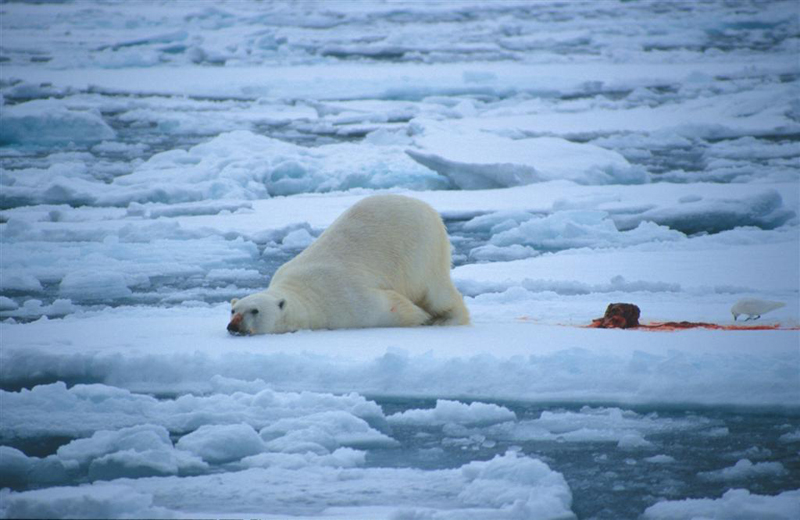Svalbard's wildlifeBy Øystein OverreinSvalbard’s wildlife is low in species diversity compared to temperate regions. However, those species that are present in Svalbard are often highly abundant, a pattern most pronounced for seabirds. Wildlife diversity peaks when migratory birds return to breed and there is intense bird activity at sea, in the bird cliffs and on the islands. This contrasts starkly with the wintertime, when only the sounds of the wind and the sea may be heard. Only the hardiest species like Svalbard reindeer, polar bears, Svalbard rock ptarmigan and Arctic foxes can be seen in winter.
You can register your observations of marine mammals around Svalbard in the Norwegian Polar Institute’s database Marine Mammals Sightings. Species living here have adapted to the extreme conditions in Svalbard. The greatest challenge is to get enough food for survival and reproduction. In winter, darkness prevails and the ground is covered in snow and ice. Herbivorous animals face their greatest challenges in winter. Very few land-living species are capable of surviving such harsh winters. The Svalbard reindeer, the Arctic fox and the Svalbard rock ptarmigan all have the capability to build energy reserves during summer and autumn, building up a layer of body fat for survival through the winter when food supply is low. Utilization of this stored fat is crucial to maintain body functions until next summer. Most birds that breed in Svalbard solve the winter problem by migrating south in late summer/autumn. They spend the winter in a more favourable climate in areas with greater food availability. The Svalbard rock ptarmigan is the only landbound bird species that overwinters in the archipelago. Among the seabirds it is normally only the common eider, the long-tailed duck and the black guillemot that overwinter in Svalbard, and only in small numbers along the coast. There are also northern fulmars and glaucous gulls at sea. The permafrost and sparse vegetation make life difficult for land mammals. For that reason, there are no mice, lemmings or other rodents this far north, with the exception of the sibling vole, an introduced species that now inhabits the lush, grassy slopes between Grumantbyen and Bjørndalen on the southern side of Isfjorden. Terrestrial mammals and birds live a hectic life during the summer months of June, July and August. Lower coastal areas are usually snow-free, there is daylight around the clock, and temperatures are high enough to allow for young to be reared. For the seals, polar bears and seabirds, all feeding at sea, the sea ice and under-ice algal bloom at the ice edge are of utmost importance. In Svalbard life in the sea and life on land are closely connected. During the breeding season seabirds transport large amounts of nutrients from the sea to the bird cliffs. A pair of little auks adds about 1 kg of faeces to the soil, which acts as fertilizer, in one season. No wonder the slopes beneath the bird cliffs are extremely green and lush. In this and other ways seabirds play an important ecological role – they enrich the ground and contribute to the lush vegetation that herbivores like reindeer, geese and ptarmigans live off. At the next trophic level in the food chain , the Arctic fox preys on these herbivores. Good light conditions and relatively high temperatures in the summer create the basis for plant production and a rich wildlife both on land and, especially, in the sea. Snow conditions on land and sea ice conditions are decisive factors. Bird cliffs and steep slopes are the first to become snow-free. Then follow islands and islets on the west coast, and lastly the flat tundra areas on the strandflats and further up the valleys. Migrating geese arriving in mid-May and onwards need snow-free areas for a successful breeding season. As soon as the conditions are right, they start breeding. In years with late snowmelt, certain species, like the Arctic tern and geese, may break off breeding to concentrate on surviving themselves. The fjord ice (fast ice), which in some places lasts until late June and even into July, are important areas for ringed seals – firstly when they give birth in March/April and later during moulting in June. The ringed seals are the nutritional basis for polar bears and Arctic foxes. Common eiders and geese will not start breeding until the sea ice connecting the main islands to their breeding grounds on smaller islands and islets has melted away. Until then they cannot be safe from the greedy egg thief: the Arctic fox. However, the birds have no protection against polar bears, which easily swim out to the islets and “vacuum” up all the eggs in a colony, leaving the birds with an abortive breeding season. The lack of trees and bushes in Svalbard means that the birds nesting here place their nests on the ground, on scree slopes or cliff ledges. Larger birds usually place their nests quite openly, while smaller birds, like the snow bunting, usually choose more protected sites in cracks, under rocks or on scree slopes. Waders place their nests on mounds of vegetation or in beach vegetation just above the high tide mark. 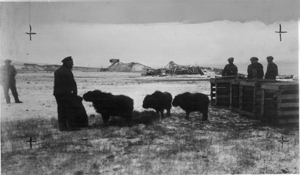
MammalsA total of 19 species of marine mammals are found in Svalbard waters. This includes polar bears, walruses, five species of seals and 12 species of whales. Of these, polar bears, walruses, narwhals, white and bowhead whales stay in the area year-round. The other species visit the area sporadically when food availability is favourable around Svalbard – in summer. There are only three species of terrestrial mammals in Svalbard: Svalbard reindeer, Arctic fox and sibling vole. The vole was most probably introduced to Svalbard in animal fodder at the Russian mining settlement of Grumantbyen. Deliberate attempts to introduce other species – Arctic hare, hare and muskox – failed to establish populations capable of living there, and they have gone extinct. House mice in fluctuating numbers are seen irregularly in the settlements. Below is a brief description of some of the species you may see along the coasts of Svalbard. (For more detailed descriptions, see the Norwegian Polar Institute’s handbook “Birds and Mammals of Svalbard”.) Polar bear (Ursus maritimus)To see the king of the Arctic probably tops the wish list for tourists visiting Svalbard. Once heavily hunted, the polar bear was protected by law in 1973. Through a joint Norwegian–Russian effort, the common population of Svalbard and Franz Josef Land – including the drift ice area – was estimated in 2004 to nearly 3000 animals. Polar bears may appear anywhere in Svalbard, but in summer they are most often seen in the north-western and northern parts of Spitsbergen, on the east coast and on Nordaustlandet and the surrounding islands. In summer, they can often be spotted in front of glaciers, where seals haul-out. The polar bears are strongly tied to the sea and sea ice, and they are proficient swimmers. In 2005, scientists documented (with the aid of a satellite transmitter) a swimming female bear crossing the fjord of Storfjorden in 24 hours. The distance is about 70 km. Polar bears often follow the ice edge northwards in summer. Some individuals have a different strategy, staying on land and starving through summer, unless they go for birds’ eggs and chicks or are lucky to find a stranded whale carcass. Such incidents can bring together several polar bears. Do remember that it is prohibited to follow, seek out or lure polar bears. This great predator has little respect for humans and dangerous situations can easily arise if people get too close. Almost every year a polar bear is killed in Svalbard after confrontations with humans or because of safety perspective in the settlements. Observing polar bears safely from the deck of a large boat is highly recommended over a close meeting on land or in a small vessel. Females with first-year cubs are extra shy and vulnerable. Keep a distance, whether meetings occur on land or on ice. 
Walrus (Odobenus rosmarus)Svalbard and Franz Josef Land have a common walrus population. The walrus was protected in 1952, at a time when the Svalbard population was down to a few hundred animals. Estimates of the Svalbard population indicated in 2006 an approximate number of 2500 animals, in 2012 the population was estimated to be 3900. The population is predominantly males, but an increasing number of females with calves in the east. Walruses are social animals and are often seen in groups when searching for mussels on the sea floor and when resting on land or during moulting. They prefer lying on ice-floes or fast ice, if possible. On land, walruses may seem undisturbed by the presence of people, and groups of males are more robust in this sense than females with calves. Anyway, one should never closely approach groups of walruses at their haul-out sites. Be aware that the walrus is a good swimmer and may attack zodiacs and kayaks at sea. Ringed seal (Phoca hispida)The ringed seal has a circumpolar distribution and is the most widespread and common seal at this latitude due to its unique ability to maintain breathing holes in the fast ice all year round. The Svalbard population is estimated to 100 000 individuals. The ringed seal is a small seal, with adult animals weighing 50–100 kg. A ringed pattern in its fur explains the common name. It is dependent on sea ice for birthing, moulting (May–July) and haul-out. During the moult, seals congregate in fjords with remaining fast ice, but disperse afterwards. Some seals move north to the ice edge, while others live in the open sea. Despite their small size they are capable of diving below 500 m. During the cruise season, ringed seals are most often observed swimming in open water. The ringed seal is wulnerable to changing climate. 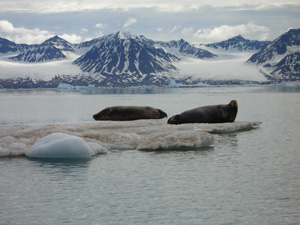
Bearded seal (Erignathus barbatus)The bearded seal is the largest of the seals in Svalbard. Females can reach weights of 425 kg in spring, while the average weight for adults on an annual basis is 250-300 kg. Males are smaller than females. Bearded seals prefer areas of shallow water with drifting pack ice. In Svalbard, they amount to several thousand animals. This seal may be seen in most fjords, often resting on ice-floes. Where not hunted, the bearded seal may seem very trustful. Moulting takes place in June, and smaller groups may be observed hauling out on the few ice-floes left in the fjords at this time. Consequently, they are a popular target for tourists photographing from small boats. It may be tempting to get really close, but be considerate and maintain a fair distance so as not to disturb the animals unnecessarily. Harbour seal (Phoca vitulina)The world’s northernmost population of harbour seals is found in Svalbard, comprising approximately 1800 animals (2010). They are concentrated at Prins Karls Forland, but in summer you may come across them all along the western coast of Spitsbergen up to the north east corner. This species weighs about 100 kg. They are social seals operating in small groups, often resting on small skerries or on rocky beaches at low tide. Other seal species that can be seen around Svalbard are harp seals and hooded seals. Bowhead whale (Balaena mysticetus)Few people ever get to see this slow-swimming giant. The bowhead whale is a large and broad whale lacking a dorsal fin. The bowed shape of their mouths has given them their name. This species reaches lengths of 14-18 m, and the female is the larger sex. Bowhead whale blows can be recognized by their V-shape. It is the only species of the baleen whales to stay in Arctic waters year round, and it is strongly tied to the ice edge. The Svalbard population is very small, but numbers are unknown – observations are rare. During the whaling era in the 1600s, 1700s and 1800s, when whaling was carried out in brutal and unscrupulous ways, this species was almost driven to extinction. It has never since recovered. When a bowhead whale was observed in Adventfjorden in 2006 it was a true sensation. In recent years there have been multiple observations yearly. The bowhead whale has been protected by law in Svalbard since 1939. 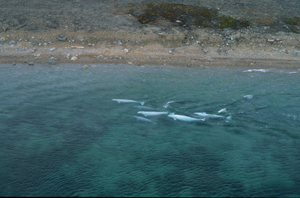
White whale (Beluga, Delphinapterus leucas)There are good chances of seeing white whales in Svalbard. This is a medium sized toothed whale, and males can reach lengths of 4.5 m and weigh 1500 kg. Females are somewhat smaller. At birth, the calves are light grey – the white colouration is not obtained until the age of seven for females and 12 for males. The number of white whales in Svalbard is not known. Being a social whale, it can often be spotted moving in groups near land. The groups are sexually segregated, with males forming separate groups from females and juveniles. In Svalbard white whales occur mostly in coastal areas, but also in areas of dense pack ice. In summer they often stay in front of glaciers where there is a good supply of food. Narwhal (Monodon monoceros)The most striking feature of the narwhal is the spiralled tusk – up to 3 m long – at the forehead of males. This toothed whale can reach lengths of 5 m and weigh 1600 kg. It lacks a dorsal fin, but has a defined dorsal ridge. Narwhals are normally seen at the ice edge, and most observations are recorded in the fjords of Nordaustlandet and in the strait of Hinlopenstretet. Narwhals are shy and will move quickly away from boats approaching them, hence they are difficult to observe. In summer they occur in all-male groups or groups of females and young . Moving on to land, there are three terrestrial mammals in Svalbard.

Svalbard reindeer (Rangifer tarandus platyrhynchus)The Svalbard reindeer is so common that tourists are almost guaranteed to see one, even up close (at least in Longyearbyen). The Svalbard reindeer is a sub-species of reindeer that only lives in Svalbard. Its short legs, short neck, small and rounded head and thick coat make up its characteristic appearance . Males are larger than females. Svalbard reindeers are widely distributed in Svalbard in areas with sufficient vegetation. The total population is estimated at 10 000 animals, and the most dense populations are found at Nordenskiöld land, in the valley of Reindalen and on the islands of Edgeøya and Barentsøya. During winter, the reindeer concentrate on ridges and plateaus with little snow cover and sparse vegetation. Early in the summer they move to lower areas, to the standflats, lowland plains, bottom of the valleys and beneath the bird cliffs where they can feed on the lush, nutritious vegetation and accumulate fat. The reindeer gives birth in June and during this period the females are dispersed and are extremely sensitive to disturbances. To get close to adult reindeer, it is best to sit down and let them come to you. In some places the reindeers may seem curious and tame while they are extremely shy in other areas. 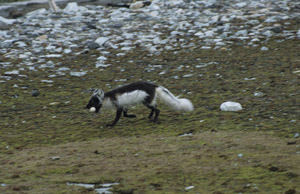
Arctic fox (Vulpes lagopus)In mainland Norway, the Arctic fox is endangered, while in Svalbard there is a large, thriving population. There are great chances of seeing foxes along the coasts of Svalbard as they are widespread in almost all of the archipelago, even on the island of Bjørnøya, where the population has been re-established over the last years. The Arctic fox is short-legged and has a short snout, short and rounded ears and a small body covered by a thick, well-insulating coat. The bottoms of the paws are covered in fur. These are all adaptations to reduce heat loss in winter. The Arctic fox appears in two colour morphs – blue and white. The white morph is uniformly white in winter, and brown and yellowish in summer. The blue fox is dark brown/blue all year round. The Arctic fox lives in two different types of areas – along the coast and inland. At the coast, the fox is closely associated with the bird cliffs, where food is plentiful in the form of eggs and chicks of common eiders, geese and seabirds. During summer, the fox hoards food in anticipation of a long and severe winter. Inland, food is less plentiful and the most important food sources here are Svalbard rock ptarmigan, waders, Svalbard reindeer and geese. Mating takes place between February and April, and in May–June the cubs (normal litter size 5-6) are born in underground dens in sandy slopes or in dens under large boulders. Dens are often located in proximity to bird cliffs. At the age of 3-4 weeks, the cubs start to play outside the den. Do not disturb Arctic foxes at their den sites, and remember the hazard of rabies! The Arctic fox is also a host of the parasite Echinococcus multilocularis (also known as fox tape worm), which can be transmitted to humans through faeces, and may be fatal.
BirdsFor cruise tourists, encounters with Svalbard’s wildlife will perhaps be dominated by seabirds. A brief introduction to some of the most characteristic follows. 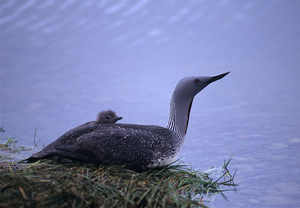
Red-throated diver (Gavia stellata)In areas with small-sized lakes and ponds and open tundra areas along the coast, this species is quite commonly seen. In flight it is easily recognized by its long neck, which is kept outstretched and slightly curved downwards, the head which is held with a slight upward curve and finally the loud and monotonous cackling “kah kah kah”. Sitting on the water, the red-throated diver emits a loud and wailing “eeaaooh”, which some may find horrifying. The red-throated diver is found throughout Svalbard, but is most common in western Spitsbergen, on Bjørnøya and in the islands of Tusenøyane. 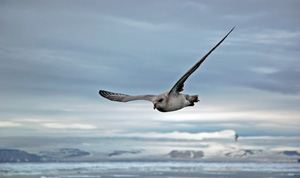
Northern fulmar (Fulmarus glacialis)Cruise tourists are guaranteed sightings of this species. There are two colour morphs of northern fulmar in Svalbard, the dark grey, which is the predominant type in Svalbard, and the light morph, which is most common in the South-Atlantic. The northern fulmar is an excellent flier as it glides on almost immovable wings over land, the ocean surface or along the ship railing. Fulmars nest in numerous bird cliffs in Svalbard. The nesting sports are visited already in February. Most of the cliffs are located along the coasts and in the fjords, but some colonies are also found inland and on nunataks. Pink-footed goose (Anser brachyrhynchus)This is the largest and most numerous of the three goose species in Svalbard. Breeding is mainly restricted to Spitsbergen. They are few in number in the east, probably because of late snow-melt. The pink-footed geese arrive in Svalbard in mid-May, migrating from their winter grounds in Belgium, the Netherlands and Denmark. On their way north, they rest in staging areas in Trøndelag (mid-Norway) and in Vesterålen (northern Norway) to build up energy reserves. They leave Svalbard in September–October. Pink-footed geese breed on islands and islets, but also at the base of slopes beneath bird cliffs or at river ravines. During the breeding season, they are extremely vulnerable to disturbances. If geese are scared away from their nests, Arctic foxes or glaucous gulls quickly appear to steal eggs. At the hatching in late June, 3-5 chicks immediately leave the nest to start wandering about with their parents. In July the adult birds moult their flight feathers, losing their ability to fly for several weeks. During this period, large flocks of pink-footed geese may be seen near rivers and lakes inland in the great valleys where they can escape the Arctic fox. Pink-footed geese are better able to protect themselves against the foxes than the barnacle geese, which are often caught on the nest while brooding. The Svalbard population of pink-footed geese has increased. At their winter grounds in Denmark, Bekgium and Netherlands, 76 000 geese were counted during the winter 2013/2014.. 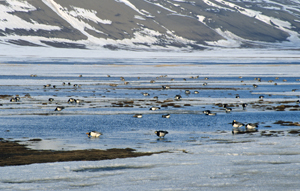
Barnacle goose (Branta leucopsis)The history of barnacle geese in Svalbard is a story of successful management of a population. After being reduced to only approximately 300 individuals after World War II, this species has increased greatly through protection and preservation of breeding and wintering grounds. In 2013 the Svalbard population was estimated at 31 500 geese. Barnacle geese arrive in Svalbard in early May, after stopping in Helgeland (northern Norway), and breed on islands and islets and on steep scree slopes on the west coast of Spitsbergen and in the archipelago of Tusenøyane. In August–September they leave Svalbard. Just after hatching, the geese families swim to areas of lush vegetation to build up energy reserves over the summer. The barnacle goose is incapable of flying during the time of moulting and will gather in flocks on lakes or at sea. Such flocks are vulnerable to disturbance. 
Brent goose (Branta bernicla)This is the smallest and fewest in number of the goose species in Svalbard – actually of all migrating goose populations in the world. Originally, the brent goose was the most numerous goose species in Svalbard, with an estimated population of approximately 500 000 geese. Excessive exploitation in the early 1900s dramatically reduced the population. In 2013 the population was down to an estimated 6800 geese in their wintering areas in England and Denmark. This number includes geese breeding in East Greenland and Franz Josef Land. The brent geese arrive in Spitsbergen in the transition between May and June after several stops along the west coast. Fuglehuken, north-west on the island of Prins Karls Forland, is one of the staging areas where geese that will continue their migration across the strait of Framstredet to breeding grounds on north-eastern Greenland stop to feed. Most of the brent geese in Svalbard breed on the islands of Tusenøyane, but some also breed in northern Spitsbergen. Common eider (Somateria mollissima)The eggs and down of the common eider were heavily exploited in earlier times, resulting in reduction in the population and subsequent protection in 1963. In Svalbard today, the breeding population is estimated to be between 13 500 and 27 500 pairs. The common eider nests in dense colonies on islands and islets on the west coast, in the north of Svalbard and on Tusenøyane. They are also found breeding scattered across the whole archipelago. Just like the geese, common eiders are extremely vulnerable to disturbances during breeding and will easily be scared off the nest, leaving their eggs exposed to egg thieves like the Arctic fox, Arctic skua and glaucous gull. In certain areas, even the polar bear may interrupt the breeding season by plundering all the nests on an island. Many important common eider breeding areas were protected in 1973, and within the protection zone traffic is prohibited throughout the breeding season. 
Svalbard rock ptarmigan (Lagopus muta hyperborea)The Svalbard rock ptarmigan is the largest terrestrial bird overwintering in Svalbard and is widespread in most of the archipelago. Greatest densities are found in central areas of Spitsbergen where plant production is highest. The Svalbard rock ptarmigan is an endemic sub-species of rock ptarmigan. The male (cock) establishes a territory in March–April, which it protects through creating a diversion and making a burping sound. Males can often be spotted sitting on a rock or high ground guarding its territory. The female (hen) lays the 9-11 eggs within the territory. As soon as the chicks are hatched, they leave the nest and start wandering about. They are capable of flying after 10-12 days, but stay with the hen for another 10-12 weeks. Purple sandpiper (Calidris maritima)The purple sandpiper is the most common wader in Svalbard. It is modest in colouration, speckled in brown, black and greyish yellow. In Svalbard the purple sandpiper nests on dry tundra throughout most of the archipelago. The total number is estimated to lie between 2000 and 10 000 pairs. This is a migratory species arriving in the middle of May and leaving in August–September to overwinter in flocks along the Norwegian coast from Tromsø in the north and all the way to the western coast of Sweden in south. In summer they are often seen restlessly seeking food in the intertidal. Nests are placed directly on the tundra, and the well-camouflaged brooding purple sandpiper is almost impossible to catch sight of. If scared off the nest, or if an intruder gets too close to the chicks, the purple sandpiper acts as if wounded; it distends the wings and lures the intruder away by running in a different direction. This is effective against the Arctic fox, among other predators. 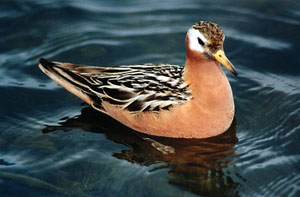
Grey phalarope (Phalaropes fulicarius) and other wadersWith its colourful plumage in red, black, yellowish brown and white, the grey phalarope is a fascinating wader. The female is the largest and most colourful of the sexes. The male incubates the eggs and rears the young. Meanwhile, the female may mate with other males and lay another clutch of eggs in a new nest. Watching the grey phalarope is a great pleasure, as it swims about in small ponds kicking up prey items (insect larvae and crustaceans) with its feet. In Svalbard the grey phalarope breeds in pairs or in small colonies throughout most of the archipelago. They migrate south starting in mid-July. 
Arctic skua (Stercocarius parasiticus)and great skua (Stercorarius skua)Most summer tourists to Svalbard become acquainted with the Arctic skua either through aerial attacks if they come too close to the nest or chicks or by observing the bird pursuing a black-legged kittiwake at great speed to steal its prey or make it drop the food it carries in the bill or disgorge food it has swallowed. Both the Arctic skua and its larger relative, the great skua, are master fliers, specializing in stealing food from other seabirds, black-legged kittiwakes and Brünnich’s guillemots in particular. Inland this species lives off carcasses and eggs and chicks of other birds. The Arctic skua has two colour phases – a light phase and a dark. The light phase is most common in Svalbard. The Arctic skua breeds all over Svalbard in single pairs. The great skua is considerably larger than its relative. Great skuas were first registered breeding on Spitsbergen in 1976, and they are now increasing in numbers both in Svalbard and on mainland Norway. In Svalbard there are now between 300 and 500 pairs. The great skua is capable of catching adult Brünnich’s guillemots in flight and killing them at the water surface. Fish and seabirds are the main prey items. From a distance the great skua may resemble a large gull, speckled brown and with white patches underneath the wings. It is most common on Bjørnøya and along the western Spitsbergen coast. Two more species of skuas may be seen in Svalbard – the long-tailed skua and the pomarine skua. The latter is not unusual in eastern Svalbard. All skuas are migratory. Glaucous gull (Larus hyperboreus)The glaucous gull is the largest of the gulls in Svalbard and can be counted as a predator, particularly at the bird cliffs. It can often be observed sitting on projections in the cliffs, guarding its own nest. It scavenges carcasses, and quickly turns up where a reindeer is being slaughtered. The glaucous gull nests throughout Svalbard either in single pairs or in small colonies. It acts as a predator, easily catching adult little auks in flight and chicks of Brünnich’s guillemot and common guillemot when the young jump from the cliffs for the first time. At the top of the food chain, the glaucous gull is strongly affected by pollutants, for instance PCBs. Black-legged kittiwake (Rissa tridactyla)The black-legged kittiwake is the most numerous of all gull species in Svalbard (also worldwide), with a population in the archipelago estimated to comprise approximately 270 000 pairs spread out in about 215 colonies. Colony sizes may vary from tens to tens of thousands of pairs. While searching for food they often occur in flocks and are easily recognizable by their miaowing call: “kitt-i-waaik, kitt-i-waaik”. 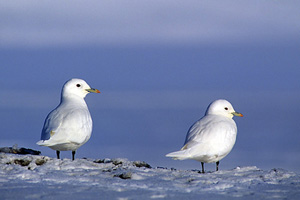
Ivory gull (Pagophila eburnea)The ivory gull is regarded the most beautiful of the gulls in Svalbard. Primarily a carrion feeder , it is often observed in the ice on top of remains from polar bear meals, as well as at dog yards or at sewage drains in the settlements. Its future is highly uncertain in Svalbard, as there is great concern that the population might have gone through the same reduction as in Arctic Canada, where monitoring programmes have shown an 80 % reduction since the 1980s. Ivory gulls nest scattered in colonies in inland Spitsbergen, on Nordaustlandet and in the Kong Karls Land islands. A total of 44 colonies are known. Through a joint Russian–Norwegian effort to register the breeding population in 2006, ivory gulls were registered in 15 localities in Svalbard and approximately 200-250 pairs were estimated to be breeding. The population is estimated to be 1 000-1 500 pairs. 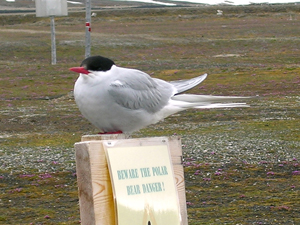
Arctic tern (Sterna paradisaea)Hovering above and dive-bombing intruders approaching nests and chicks, the aggressive Arctic tern is encountered by most tourists visiting Svalbard. The aggression is understandable, as it is only trying to raise its chicks after having migrated all the way from Antarctica to reproduce during the short Arctic summer. Avoid walking into or staying at such colonies for this reason. Arctic terns occur throughout Svalbard, but are most numerous in western and northern Spitsbergen. The population is estimated to be less than 10 000. They usually nest in colonies of up to several hundred pairs, located in or close to the beach zone. Common guillemot (Uria aalge) and Brünnich’s guillemot (Uria lomvia)Large bird cliffs often house one of these species, which are strikingly similar and may easily be confused. Both birds have dark (black in the case of Brünnich’s guillemot and brown-black in the case of the common guillemot) upper parts and white underparts. The common guillemot has a longer and thinner bill, lacking the white line at the base of the upper bill that characterizes the Brünnich’s guillemot. Common guillemots also have dark mottling on their flanks. Bjørnøya is the most important breeding area for the common guillemot, which has a more southerly distribution than its relative. Tens of thousands of common guillemots nest densely packed on ledges in large, steep bird cliffs. Capelin is the main prey item. At about three weeks of age, in the second half of July, the chicks jump from the cliffs. This behaviour is synchronized, and the young try to glide in the air on their stiff, untrained wings, to reach the sea without being caught by glaucous gulls, Arctic foxes or other predators. This is a critical period for the chicks and tourists should keep a fair distance to bird cliffs during this event. Total population of Common guillemot is estimated to be 100 000 pairs. The Brünnichs guillemot is purely black and white. It is one of the most numerous seabird species in Svalbard, and widespread throughout the archipelago in 142 breeding colonies. The largest of the colonies house a hundred thousand pairs each, and are found in south-eastern Spitsbergen, on Hopen and on Bjørnøya. The total population is estimated to be 850 000 pairs. 
Little auk (Alle alle)The little auk is the smallest of the European auks. Upon arrival in Svalbard in April, they spread hustle and bustle along the coasts. Little auks fly in synchrony to and from the breeding sites, while tens of thousands feed in flocks on the water further out at sea. Visitors who experience the teeming bird life in June at one of the large colonies will never forget the sight and roaring chorus from the swarming little auks. The little auk makes lots of noise and this accounts for the popular name “tromsøværing”, – a native of Tromsø. The little auk is the most numerous bird in Svalbard, estimated populatioj is less than 1 million. It is widespread across the archipelago, but more numerous in the south-western and north-western parts of Spitsbergen. A total of 207 colonies are known. 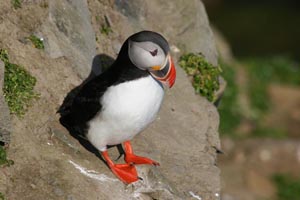
Atlantic puffin (Fratercula arctica)The last seabird to be mentioned here is the Atlantic puffin, also known as the sea parrot because of its colourful bill. Svalbard is the northernmost distribution area for the Atlantic puffin and the numbers here are low (approximately 10 000 pairs are indicated, but estimates are highly uncertain). Only about 50 colonies are known, from Bjørnøya in the south, along the west coast of Spitsbergen, and north to the islands of Sjuøyane. Atlantic puffins breed in crevasses and cavities between rocks. In Svalbard it is not possible to make nest burrows as these birds do in colonies on mainland Norway. 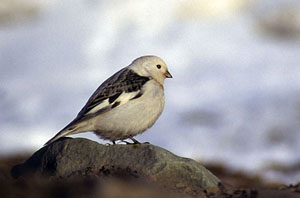
Snow bunting (Plectrophenax nivalis)Visitors travelling inland will meet the snow bunting, the only songbird in Svalbard. When the snow bunting returns in April, its melodious lark-like song revives nature in Svalbard – in stark contrast to and in competition with noise from snowmobiles and other man-made sounds. The snow bunting is the most northerly passerine bird in the world. It nests in most areas of Svalbard, and occurs on the coast and inland, and also in the settlements, where it can find good nesting sites. Its main food is insects. In August–September it leaves Svalbard and migrates south to the Russian steppes north of the Caspian Sea and Kasakhstan for overwintering. Updated May 2015 |
The Cruise Handbook is also available in book formHard cover with numerous pictures - 249 pages - NOK 249.00 Norwegian Polar Institute |
 Norsk
Norsk